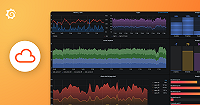Setup eBPF Profiling on Kubernetes
To set up eBPF profiling with Grafana Agent on Kubernetes, you need to:
- Verify that your cluster meets the prerequisites.
- Add the Grafana helm repository.
- Create a Grafana Agent configuration file. For more information, refer to Configuration reference.
- Install Grafana Agent.
- Verify that profiles are received.
Caution
Grafana Alloy is the new name for our distribution of the OTel collector. Grafana Agent has been deprecated and is in Long-Term Support (LTS) through October 31, 2025. Grafana Agent will reach an End-of-Life (EOL) on November 1, 2025. Read more about why we recommend migrating to Grafana Alloy.
Prerequisites
Before you begin, you need:
- Helm and kubectl installed with access to your Kubernetes cluster.
- A Pyroscope server where the Agent will send profiling data.
- Access to Grafana with the Grafana Pyroscope data source provisioned.
Note
If you don’t have a Grafana and/or a Pyroscope server, you can use the [Grafana Cloud][gcloud] free plan to get started.
Verify that your cluster meets the requirements
The eBPF profiler requires a Linux kernel version >= 4.9 (due to BPF_PROG_TYPE_PERF_EVENT).
BPF_PROG_TYPE_PERF_EVENT is a type of eBPF program that can be attached to hardware or software events, such as performance monitoring counters or tracepoints, in the Linux kernel.
To print the kernel version of each node in your cluster, run:
kubectl get nodes -o jsonpath='{range .items[*]}{.metadata.name}{"\t"}{.status.nodeInfo.kernelVersion}{"\n"}{end}'Make sure all nodes have a kernel version >= 4.9.
Add the Grafana Helm repository
We recommend using Helm to install Grafana Agent. To add the Grafana Helm repository, run:
helm repo add grafana https://grafana.github.io/helm-charts
helm repo updateVerify that the repository was added successfully by running:
helm search repo grafana/grafana-agentIt should return a list of available versions of Grafana Agent.
Create a Grafana Agent configuration file
Create a file named values.yaml with the following content:
agent:
mode: 'flow'
configMap:
create: true
content: |
discovery.kubernetes "local_pods" {
selectors {
field = "spec.nodeName=" + env("HOSTNAME")
role = "pod"
}
role = "pod"
}
pyroscope.ebpf "instance" {
forward_to = [pyroscope.write.endpoint.receiver]
targets = discovery.kubernetes.local_pods.targets
}
pyroscope.write "endpoint" {
endpoint {
basic_auth {
password = "<PASSWORD>"
username = "<USERNAME>"
}
url = "<URL>"
}
}
securityContext:
privileged: true
runAsGroup: 0
runAsUser: 0
controller:
hostPID: trueReplace the <URL> placeholder with the appropriate server URL. This could be the Grafana Cloud URL or your own custom Pyroscope server URL.
If you need to send data to Grafana Cloud, you’ll have to configure HTTP Basic authentication. Replace <User> with your Grafana Cloud stack user and <Password> with your Grafana Cloud API key.
Note
If you’re using your own Pyroscope server, you can remove thebasic_authsection altogether.
For more information, refer to the Configure the Grafana Pyroscope data source documentation.
Install the Grafana Agent
To install the Grafana Agent, run:
helm install pyroscope-ebpf grafana/grafana-agent -f values.yamlOnce configured, the Agent starts collecting eBPF profiles and send them to the Pyroscope server.
Verify profiles are received
To verify that the profiles are received by the Pyroscope server, go to the Pyroscope UI or Grafana Pyroscope datasource. Select a profile type and a service from the drop-down menu.


